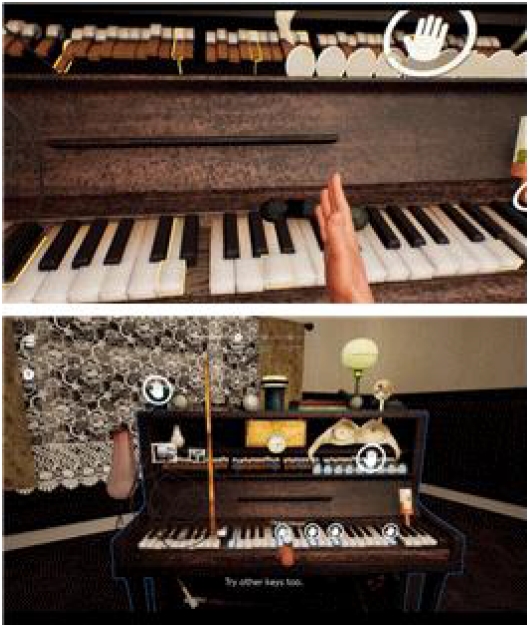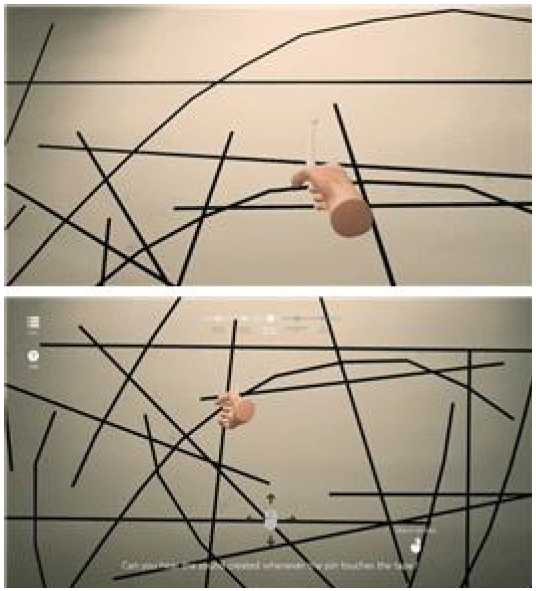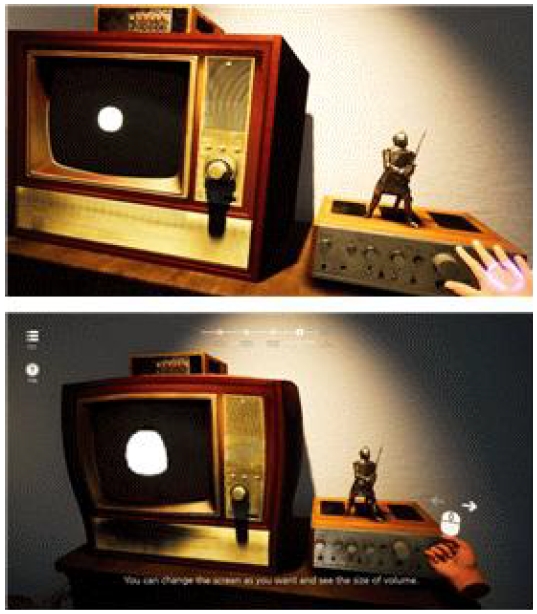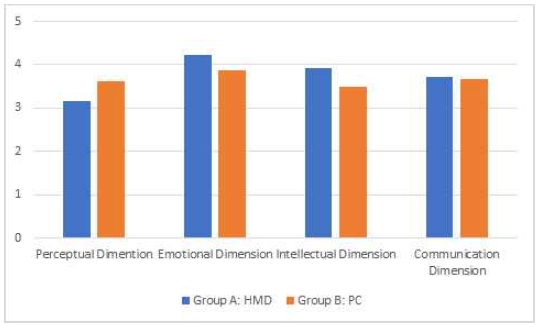
A Study on the Aesthetic Experience of Exhibition Visitors by Virtual Reality Type, Focusing on Nam June Paik's Exhibition 'Exposition of Music'
Copyright ⓒ 2023 The Digital Contents Society
This is an Open Access article distributed under the terms of the Creative Commons Attribution Non-CommercialLicense(http://creativecommons.org/licenses/by-nc/3.0/) which permits unrestricted non-commercial use, distribution, and reproduction in any medium, provided the original work is properly cited.

Abstract
Nowadays, virtual reality exhibitions are an alternative to provide visitors with a new experience. In this study, we developed HMD-based immersive exhibitions for visitors in exhibition halls, and virtual reality exhibitions for visitors with a minimal personal PC setup. The focus was on Nam June Paik's Exhibition ‘Exposition of Music’, to compare and analyze the aesthetic experience offered by both types of exhibitions. First, the meaning of aesthetic experience in virtual reality exhibitions was defined, and the experience was empirically designed to accommodate a virtual reality exhibition environment in the HMD setup and PC setup. In addition, a survey was conducted on the aesthetic experiences of visitors of the two different systems, to analyze the advantages and disadvantages of each system, and build a foundation for more developed virtual reality exhibitions in the future.
초록
현재 가상 현실 전시회는 방문객들에게 새로운 경험을 제공하는 대안으로 떠올랐다. 본 연구에서는 백남준의 ‘음악의 전시’를 중심으로 전시장 내 관람객을 위한 HMD 기반 몰입형 전시회와 최소한의 개인 PC 설정으로 관람객을 위한 가상현실 전시회를 개발하여 두 유형의 전시회가 제공하는 미적 경험을 비교 분석하였다. 첫째, 본 연구에서는 가상현실 전시회에서 심미적 경험의 의미를 정의하였으며, 경험은 HMD 설정과 PC 설정에서 가상현실 전시 환경을 수용할 수 있도록 경험적으로 설계되었다. 또한 시스템별 장단점을 분석하고 향후 더욱 발전된 가상현실 전시회를 위한 기반을 구축하기 위해 서로 다른 두 시스템의 관람객들의 미적 경험에 대한 설문조사를 실시하였다.
Keywords:
Virtual Reality, Exhibition, Aesthetic, Experience, Visitor키워드:
가상현실, 전시, 미적, 경험, 관람객Ⅰ. Introduction
Nowadays, modern art galleries tend to focus more on the visitor experiences when presenting new exhibits, which is a move away from the more conventional approach of focusing on the collections. This is a result of converging art and state-of-the-art technology, representing the 4th Industrial Revolution, and it led to rapid changes in how visitors appreciate the exhibitions. Nowadays, with the outbreak of the COVID-19 virus, people have become accustomed to a virtual lifestyle and have started to enjoy cultural activities in virtual spaces without having to visit offline spaces in person.
If conventional exhibition halls have presented exhibitions that convey information about the exhibits to the public to help them understand the exhibits, recently exhibitions, with the development of technology, have started to shift the focus to encouraging the visitors to be the active participants in discovering their own knowledge about the exhibits, through participation and interaction[1]. Specifically, exhibitions, incorporated with virtual reality, have the advantage of enabling visitors to appreciate the exhibitions anytime and anywhere without having to visit the off-line exhibition halls in person and only require devices, such as personal computers or HMDs. To build a virtual reality exhibition hall, the displayed exhibits are scanned in 3D, which are posted online on a digital platform. Google Arts&Culture is one representative online platform that has collaborated with more than 1,800 cultural and artistic organizations around the world[2]. Anyone can enjoy access to all the artworks from the exhibitions anytime and anywhere by visiting the platform. These virtual reality exhibitions allow both the visitors to experience exhibitions without restrictions on time and space, and the art galleries and museums to greet these visitors in an online space.
Many studies have been conducted on the immersion effects and the production methods of virtual reality exhibitions, but there has been a lack of discussion on the aesthetic experiences, that virtual reality exhibitions provide. No research has focused on the different effects of aesthetic experiences, based on the environments of the virtual reality exhibitions. In addition, existing virtual reality exhibitions are often developed as one type of exhibition content, making it difficult to identify the advantages and disadvantages of exhibitions according to the type of virtual reality. The present research recreates Nam June Paik’s ‘Exposition of Music,’ an exhibition representing the convergence of artwork and virtual reality technology, in both HMD-based and PC-based versions. Comparing the aesthetic experiences of each virtual reality environment, the research proposes an ideal direction that many virtual reality exhibitions should pursue in the future. In addition, we intended to derive advantages and disadvantages according to the type of exhibition by comparing and analyzing virtual reality exhibition contents according to the type of virtual reality. To this end, the meaning of aesthetic experience in virtual reality exhibition was first defined and a survey was conducted to compare the effects of different interaction methods on the visitors.
Ⅱ. Related Works
2-1 Aesthetic Experience
The word ‘aesthetic’ from ‘aesthetic experience’ stems from the Greek word ‘aesthesis,’ which is defined as sense perception or sensory cognition. In other words, the term ‘aesthetic experience’ can be viewed as an experience obtained through sense perception or sensory cognition. For the experience, obtained through the five senses, to be defined as an aesthetic experience, a certain aesthetic attitude must be premised. In 『The Phenomenology of Aesthetic Experience』, Dupren states that the perceiver’s perception is what completes a work of art as a truly aesthetic object that triggers an aesthetic perception. Before perception, a work of art only exists in a form of the text of a symbol system, but perception is what allows the meaning behind the work to be interpreted and finally transform the work of art from a potential existence to a real existence. Dupren defines aesthetic experiences as sensory events that lead humans to be aware of the originality of human existence and live in harmony with the world and focuses on the aspects of the perceivers’ emotions[3].
Dewey[4] argued that aesthetic experience is the most complete and ideal type of experience among the various concepts of experience, and is characterized by an aesthetic quality, that distinguishes it from everyday ‘experiences’. Aesthetic experience is the most appropriately organized, integrated, and perfect form of experience. Csikszentmihalyi and Robinson(1990)[5] said that it is the ‘aesthetic experience’ that becomes the foundation of appreciation and provides entertainment for the exhibition visitors. This experience applies not only for appreciating works of art, but also for other human activities, including sports, exploration, and games. Among all the empirical elements that can be obtained from exhibitions, we focused on the interaction experience of visitors' appreciation. In this research, 'experience' is defined as an aesthetic experience that visitors acquire through appreciation and interaction in a virtual exhibition. For an appreciative experience, the visitor can gradually change his or her perception of art, with newly created emotions and experiences that stem from intervening in his or her own experience in the work. Through the exhibition, visitors can understand the message that the artist wants to convey and experience a sentimental artistic discourse.
2-2 VR Exhibitions
COVID-19 has changed the shape of the exhibition space that has been dependent on offline so far. With the spread of social distancing and non-face-to-face services, exhibition halls have expanded online exhibitions so that visitors can watch various exhibitions through mobile or PC through the special VR exhibitions. These online VR exhibition halls can be said to be useful content for visitors who are unable to visit the exhibition hall in person, but they are insufficient to provide the immersion and realism of offline exhibitions. Kim Geum-young[6] researched a visual expression element evaluation target for domestic online VR exhibitions and analyzed them, saying that the design of visual expression elements is insufficient as if the structure of navigation is complex and inconvenient to use.
Virtual reality exhibitions are usually experienced from a first-person perspective, and visitors can participate in the exhibition through interactions such as touching works that were prohibited in ordinary art galleries and museums[7]. In addition to the online VR exhibition hall, HMD-based immersive exhibitions are also on the rise to provide more immersive exhibition content to visitors who visit the exhibition hall. According to a study on the current status of exhibition spaces using virtual reality, actual experiences in virtual spaces increased audience satisfaction and immersion, and the form of an immersive virtual reality system using physical interaction showed the highest satisfaction and immersion[8]. However, there is still a limit to providing HMD to many visitors, and it is difficult to operate it. As such, many exhibition halls are actively developing online-based VR exhibitions and offline-based immersive VR exhibitions, and both forms have advantages and disadvantages.
2-3 Visitor Experience
The exhibition is not complete with only the intrinsic value of the exhibit, as the true meaning and value of the work can only be evaluated through the visitor experience and reaction[9]. Gardener and Heller(Gardener & Heller 1960)[10] stated that a qualitative assessment of how visitors react to the exhibit is as significant as the total number of visitors, and McLean also stated that exhibition experience provides social and sensory experiences, which are not available from books, TV, movies, or amusement parks[11]. Doering, Pekarik, and Karns(Doering, Pekarik & Karns, 1999)[12] conducted a pilot study to gain insights into art gallery exhibitions and visitor experience and the result indicated that the majority of visitors felt high levels of satisfaction with exhibitions and cognitive experiences, while feeling mostly unsatisfied with self-reflection or social experiences. In a study about the experience and satisfaction of art gallery visitors, Rojas and Carmen(De Rojas & Carmen, 2006)[13] argued that motivation for the visit influences the exhibition experience and that the exhibition experience ultimately leads to overall satisfaction with the art gallery.
With our recreation of Nam June Paik’s virtual reality exhibition, we aimed to compare the effects of different interaction experiences provided by each virtual reality environment by conducting a survey, which was based on the different experiences of the visitors that visited the site in person and the visitors that accessed the exhibition through personal computers at homes.
Ⅲ. Exposition of Music
Nam June Paik was an artist who was ahead of his time. Paik was especially interested in the technology media called TV and presented his work, using 13 TV sets, in 1963 at his first solo exhibition "Exposition of Music – Electronic Television", which was hosted in Wuppertal, Germany. In collaboration with the Nam June Paik Art Center, we recreated Nam June Paik's first solo exhibition 《Exposition of Music—Electronic Television》 with virtual reality technology. We digitally recreated the representative works of 13 Experimental Televisions, 2 Prepared Pianos, and 1 Random Access based on the remaining black-and-white exhibition photos and literature information. Since <Exposition of Music> was an exhibition that included instantaneous interaction elements such as visitor participation and the artist’s performance, only the photos, and the visitors were the remaining accounts of the exhibition. Based on these records and writings on the artist’s main theme, we tried to represent the art as communication, just as how the artist wanted to convey through "Exposition of Music", using virtual reality technology.
Nam June Paik's "Exposition of Music" intended to exhibit music as the title suggests. Paik declared that he will “exhibit music” and even included everyday sounds(noises), performances, and visitor participation, all of which have been regarded as ‘outsiders’ from the traditional definition of music[14]. Realizing that music includes not only all types of sounds but also performances, Paik intended to exhibit music that includes the performances and sounds of the visitors. In ‘Exposition of Music,’ we produced a virtual reality exhibition, based on the selection of three works as shown in Figure 1~3, which could best represent the aesthetic experiences of the visitors in the HMD-based virtual reality space and PC environment.
Ⅳ. Design and Implementation
4-1 Empirical Design based on Virtual Reality Devices
In this research, two different virtual reality environments, an HMD-based immersive exhibition, and a PC-based home exhibition were selected to recreate Nam June Paik's virtual reality exhibition. Although HMD-based immersive virtual reality exhibition has the advantage of providing a highly immersive experience, it requires an independent virtual reality system and might require assistance for visitors who are not familiar with the HMD environment, resulting in additional costs and low scalability. To compensate for these shortcomings, a PC-based home virtual reality exhibition was developed in parallel which can allow visitors to download and access the application with any personal computer setup at home. Despite being easily accessible to the public and not requiring any extra devices, a PC-based virtual reality exhibition lacks in providing a highly immersive experience because the visitor can only experience the virtual environment through a monitor and a mouse. We have already derived the advantages and disadvantages of existing virtual reality exhibitions as shown in Table 1 from our past research[15].
Both virtual reality environments included the same exhibits of Galerie Parnass and Nam June Paik, with the same narration explaining these exhibits, but the interactions between the exhibits and the visitors differed greatly, due to the inherently different nature of HMD and PC environments. Especially, since Name June Paik’s ‘Exposition of Music’ was an exhibition where the interpretation of the exhibits relied greatly on the interactions with the visitors, it was significant to compare the aesthetic experiences of the visitors who had experienced two different interactions with two different spaces.
The highly interactive exhibits from the exhibition were the Prepared Piano, Random Access, and one of the Experimental Television Rooms, all of which were only meaningful when interacted with the visitors in the actual exhibition. The Prepared Piano provides the visitors with an audio-visual experience by making unexpected sounds or flickering the lights attached to the piano when the visitors press the piano keys. In Random Access, visitors can pick up a pin and scratch pieces of tape that are cut and pasted onto the wall to make random sounds. Inside an Experimental TV room, visitors can turn the dial of the television to make the dot on the screen larger or smaller. All these interactions provide the opportunity to transform the conventionally static attributes of piano, tape, and television through the intervention of the visitors, ultimately creating new forms of art.
As illustrated in Table 2, we designed the experience in a virtual reality system to closely replicate the physical experiences of the visitors in interacting with the exhibition, which is a pivotal part of the experience. The HMD version was developed, based on Oculus Quest 1 and we designed interactions, based on the controller provided by Oculus. Hand movements, including holding objects and naturally moving hands, were implemented using the key on the controller, while movements in space were provided with two options for the visitors, to replicate the actual movement of the visitor or to teleport through different spaces, using the controller.
For the PC version, the main interactions were designed to be possible with a mouse and a keyboard to implement a monitor-based virtual reality environment. The main interaction between the visitor and the exhibit was executed using a mouse, and the hand movement was implemented by allowing the visitor to use the right button to hold the object with the mouse. Using a mouse and a keyboard, PC users could freely navigate the virtual reality space without difficulties.
4-2 Evaluation of Aesthetic Experience
Csikszentmihalyi and Robinson(1990) found that the characteristics of aesthetic experience can be classified into four categories. Although they acknowledged that the contents of aesthetic experience were bound to be different, due to the inherently different nature of an individual’s environment and internal structure, they argued that the ‘structure’ in which the aesthetic experience occurs could be universally applied to everyone[5].
We attempted to compare the visitors' aesthetic experiences through HMD-based and PC-based virtual reality exhibitions. Based on the aesthetic experience model, theoretically established by Csikszentmihalyi and Robinson, the four areas(factors) of aesthetic experience were each defined with sub-evaluation factors, to make the model applicable in the context of a virtual reality exhibition, as shown in Table 3.
In order to evaluate the aesthetic experience experienced by visitors through exhibition content, a survey was conducted according to three factors as shown in Table 4. For the evaluation of each variable, the 5-point Likert scale was utilized, typically used to evaluate responses on attitude and perception.
Ⅴ. User Survey
5-1 Survey Method
We conducted a survey on the aesthetic experiences of 30 visitors who visited the visited the Nam June Paik Art Center to experience the HMD-based virtual reality exhibition and another 30 visitors who experienced the PC-based virtual reality exhibition at home. Of all the visitors, there were 25 men and 35 women, and all the visitors were aged between 18 and 45(M = 30.25, SD = 9.53). All the visitors were sufficiently notified of the possible side effects or after-effects of using a virtual reality device, and all survey participants voluntarily participated in the survey with consent. Visitors who experienced the HMD in the Nam June Paik Art Center conducted a survey right after the exhibition experience on-site, while an online survey was conducted for visitors who experienced the PC version.
5-2 Survey Results
Analysis of the survey results as shown in figure 4 for Group A that experienced the HMD-based virtual reality exhibition and Group B that experienced the PC-based virtual reality exhibition revealed that Group A received better evaluations than Group B in both Emotional Domain, with 4.22 for Group A and 3.87 for Group B, and Intellectual Domain, with 3.91 for Group A and 3.48 for Group B. However, for Perceptual Domain, Group B received 3.62, which is a higher evaluation than Group A’s 3.15. The evaluation results were similar for both groups in the Communication Domain, receiving 3.71 and 3.68 respectively for Group A and Group B. Based on the results, we analyzed that since visitors who put on HMDs and experienced virtual exhibitions through controllers had the opportunity to appreciate Paik's other works on site, they generally had higher emotional connections to the exhibition, thus a higher understanding of the exhibition theme.
In addition, visitors that experienced the PC-based virtual reality exhibition at home could spend more time appreciating the virtual reality exhibition without time constraints, indicating that they had sufficient time to perceptually interact with the exhibits in the virtual environment. Lastly, both groups of visitors, whether they were at the exhibition site or at home, showed high levels of the Communication Domain because both HMD and PC environments were designed to enable sufficient interactions with the exhibits, with the help of interfaces such as controllers and mice.
As a result, visitors who wore HMD and watched the exhibition were able to have a deeper emotional connection with the exhibition and the artist through the text, narration, and physical interaction of the exhibition in an immersive environment. In addition, visitors who watched the exhibition in a PC environment showed that the degree of perception of the work increased by fully enjoying the exhibition content for a longer time in a free environment without HMD. Through this, we were able to derive that if the goal of the exhibition content is an exhibition that values emotional communication between the work and the artist, an immersive VR exhibition through HMD will be appropriate, and a PC-based VR exhibition will be appropriate if the exhibition information is delivered through continuous interaction with the exhibition for a long time.
Ⅵ. Conclusion
In this research, we recreated Nam June Paik's first solo exhibition, 'Exposition of Music', through two systems, an HMD device-based system, and a PC-based system, to compare and analyze the aesthetic experiences of the virtual reality exhibitions for visitors, either on the exhibition site or at home. For this, the meaning of aesthetic experience first had to be defined and the empirical design elements of virtual reality exhibition were derived to design the interactive experiences for the two systems of the virtual reality exhibition. After conducting a survey of the visitors, we found that the HMD-based immersive virtual reality exhibition, located inside the art gallery, received higher evaluations in both Emotional Domain and Intellectual Domain, compared to the PC-based home virtual reality exhibition. On the contrary, PC-based home virtual reality exhibitions received better evaluations in the Perceptual Domain, while both systems received similarly high evaluations in the Communication Domain. As such, the exhibition experience design applied to both systems has advantages and disadvantages, and in the future, different systems and empirical designs may be applied, depending on the exhibition halls and the nature of the exhibition.
Although this research developed an exhibition experience design for an individual person, more research should be carried out on multi-user platforms that can be jointly enjoyed by multiple visitors in the future and the related empirical designs. An exhibition hall is a place where messages are delivered through works created by artists. Each of these works has a different purpose, and it is very important what aesthetic experiences will be provided to effectively convey them to visitors. Through this study, I hope that VR exhibitions to be developed in the future will be a study that can provide visitors with aesthetic experiences through effective VR types.
References
- M. Y. Jung, “Study on the Development Plans for Education at Museums by Utilizing Digital Technology - Centered on the Cases of the Education Programs of Gyeongju National Museum and the Exhibition Contents of the Children's Museum thereof,” Museum Education, Vol. 3, pp. 29-51, 2019.
- Goodle. Goodle Art & Culture [Internet]. Available: https://artsandculture.google.com/
- M. Dufrenne, The Notion of the A Priori, Edward S. Casey (Trans.), Evanston: Northwestern University Press, p. 57, 1966.
- J. Dewey, Art as Experience, New York: Putnam, 1980.
- M. Csikszentmihalyi and R. E. Robinson, The Art of Seeing : An Interpretation of an Aesthetic Encounter, Malibu, CA: J.P. Getty Museum, 1990.
-
K. Y. Kim, “Visualization Methods for 360° VR Images-Focused on Domestic Online Exhibitions,” Journal of Cartoon & Animation Studies, No. 66, pp. 307-332, March 2022.
[https://doi.org/10.7230/KOSCAS.2022.66.307]

- K. J. Kim, “Information Visualization and Interactive Presentation Methods in Media Art,” Broadcasting and Media Magazine, Vol. 21, No. 2, pp. 36-50, 2016.
- H. G. Jeoung and K. C. Chang, “A Study on the Present Status of Exhibition Space Using Virtual Reality,” Journal of Art & Design Research, Vol. 21, No. 2, pp. 58-66, 2018.
- J. Y. Yang, “Research Performance and Project on Art Gallery Visitors : Focusing on the U.S. Research after the 20th Century,” Art Business Research, Vol. 3, pp. 68-97, 2003.
- J. Gardner and C. Heller, Exhibition and Display, F.W. Dodge Corporation, 1960.
- H. K. Ahn, Research on the Interpretation Method of Museum Exhibition : For Communication between Exhibition and Different Visitors, MA dissertation, Choongang University, Seoul, 2000.
-
A. J. Pekarik, Z. D. Doering, and D. A. Karns, “Exploring Satisfying Experiences in Museums,” Curator : The Museum Journal, Vol. 42, No. 2, pp. 152-173, April 1999.
[https://doi.org/10.1111/j.2151-6952.1999.tb01137.x]

-
M. d. C. de Rojas and M. d. C. Camarero, “Experience and Satisfaction of Visitors to Museums and Cultural Exhibitions,” International Review on Public and Non Profit Marketing, Vol. 3, pp. 49-65, June 2006.
[https://doi.org/10.1007/BF02893284]

- N. J. Paik, About the Exposition of Music, Décollage, Vol. 3, unpaged, 1962.
-
J. Y. Kang, “Development of Home VR Exhibition Based on Nam June Paik's First Solo Exhibition 'Exposition of Music',” Journal of Digital Contents Society, Vol. 24, No. 1, pp. 33-43, January 2023.
[https://doi.org/10.9728/dcs.2023.24.1.33]

저자소개

2004년 : Pratt Institute 컴퓨터 그래픽스(학사)
2006년 : New York University, 인터랙티브 텔레커뮤니케이션(석사)
2013년 : 한국과학기술원(공학박사-인터랙션 디자인)
2022년~현 재: 이화여자대학교 커뮤니케이션 미디어학부 교수
※관심분야 : 가상현실(VR), 증강현실(AR), 인터랙션 디자인 등




